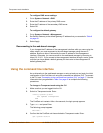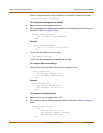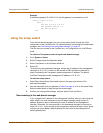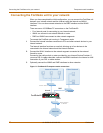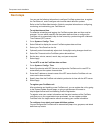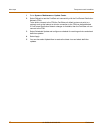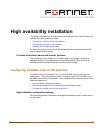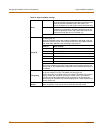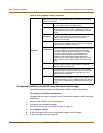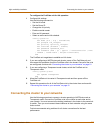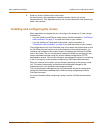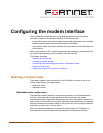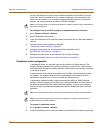
High availability installation Configuring FortiGate units for HA operation
FortiGate-60 Installation Guide 01-28008-0018-20050128 49
Configuring FortiGate units for HA using the web-based manager
Use the following procedure to configure each FortiGate unit for HA operation.
To change the FortiGate unit host name
Changing the host name is optional, but you can use host names to identify individual
cluster units.
1 Power on the FortiGate unit to be configured.
2 Connect to the web-based manager.
See “Connecting to the web-based manager” on page 16.
3 Go to System > Status.
4 In the Host Name field of the Unit Information section, select Change.
5 Type a new host name and select OK.
Schedule
The schedule controls load balancing among the FortiGate units in the
active-active HA cluster. The schedule must be the same for all FortiGate
units in the HA cluster.
None No load balancing. Select None when the cluster interfaces
are connected to load balancing switches.
Hub Load balancing for hubs. Select Hub if the cluster interfaces
are connected to a hub. Traffic is distributed to units in a
cluster based on the Source IP and Destination IP of the
packet.
Least
Connection
Least connection load balancing. If the FortiGate units are
connected using switches, select Least connection to
distribute traffic to the cluster unit with the fewest
concurrent connections.
Round Robin Round robin load balancing. If the FortiGate units are
connected using switches, select round robin to distribute
traffic to the next available cluster unit.
Weighted
Round Robin
Weighted round robin load balancing. Similar to round
robin, but weighted values are assigned to each of the units
in a cluster based on their capacity and on how many
connections they are currently processing. For example,
the primary unit should have a lower weighted value
because it handles scheduling and forwards traffic.
Weighted round robin distributes traffic more evenly
because units that are not processing traffic will be more
likely to receive new connections than units that are very
busy.
Random Random load balancing. If the FortiGate units are
connected using switches, select random to randomly
distribute traffic to cluster units.
IP Load balancing according to IP address. If the FortiGate
units are connected using switches, select IP to distribute
traffic to units in a cluster based on the Source IP and
Destination IP of the packet.
IP Port Load balancing according to IP address and port. If the
FortiGate units are connected using switches, select IP Port
to distribute traffic to units in a cluster based on the Source
IP, Source Port, Destination IP, and Destination port of the
packet.
Table 10: High availability settings (Continued)



